El Ati Rudra Maha Yagnam
El profundo significado del sacrificio del POTENTE
We reproduce below, the text of a special Musings talk by Prof G. Venkataraman on the subject of Ati Rudra Maha Yajna, broadcast earlier over Radio Sai.
Afectuoso Sai Ram y saludos desde Prashanti Nilayam. El Ati Rudra Maha Yajna se encuentra ahora en plena marcha aquí, y es apropiado que Dedico esta charla especial a ese tema. Antes de decir cualquier cosa en el Yajna adecuada, debo ofrecer por primera vez la advertencia de que no soy un erudito védico. Diga lo que diga en los aspectos técnicos se basa en material que he obtenida de diversas fuentes, incluidos los eruditos detrás del evento aquí. Es probable que no se pueden producir errores debido a lo incompleto de mi entendimiento, para lo cual hago mis disculpas por adelantado.
El Ati Rudra Maha Yajna se dirige específicamente al Señor Shiva; como tal, mis observaciones se estructuran de la siguiente manera:
Comenzaré por decir algo sobre este particular yajna , los aspectos que cantan que se muestran.
- A continuación, teniendo en cuenta que este Yajña se dirige al Señor Shiva, voy a decir algo sobre Siva, como Él está representado, y lo que significa que la representación.
- Esto entonces me llevan a algunos más comentarios sobre los cantos que caracterizan a este particular yajna .
- Después de esto, voy a decir algo sobre lo que realmente hay detrás de adoración ritual, etc.
- Voy a continuación, terminar con algunas observaciones generales sobre el significado más amplio de este Yajña y por qué es importante.
Los cantos de los Rudram
Con este preámbulo, déjame ir al grano y empezar con Rudram . La palabra Rudram por lo general se refiere a un canto especial, una célebre realidad, que se produce en el Yajur Veda . El Rudram se escucha casi todos los días aquí en Prashanti. Debo señalar que lo que comúnmente se conoce como el Rudram , tiene dos partes; el primero de ellos es el llamado el Namakam mientras que el segundo se llama Chamakam . La mayor parte de los himnos de el Namakam terminar con las palabras namo o namaha . Del mismo modo, el final de muchos de los himnos de Chamakam es mi cha. Los himnos están organizados en porciones llamados Anuvakams .
Normalmente, un canto de la el Namakam seguido por uno canto de la Chamakam constituye uno Rudram . Existe la creencia tradicional de larga data de que el canto del Rudram confiere beneficios de diversa índole. Por ejemplo, el canto es una libertad pocas veces subvenciones de la enfermedad, las dificultades mundanas, etc. A medida que el número de los aumentos de repetición, uno se supone que se van haciendo progresivamente más y más beneficios, pero en algún momento, los beneficios de cambiar del ser mundano a lo espiritual, siendo la culminación ser uno con Dios. En funciones como la que ocurre aquí, la palabra Rudram que representa la unidad básica de canto se define de forma ligeramente diferente. Glossing ligeramente en los detalles, la unidad básica consiste en el canto de los el Namakam 11 veces seguido de un canto de la Chamakam . Si las personas once hacen esto al mismo tiempo, tenemos esencialmente 11x11 o 121 cantos colectivos, que se llama ekādaśa Rudram . | 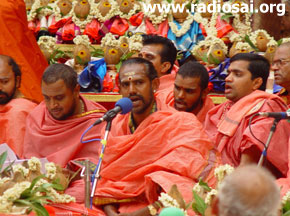 | |
mantras melífluas |
Cuando el módulo básico se canta o 11x11x11 1.331 veces, tenemos un Maha Rudram , y cuando se canta o 11x11x11x11 14.641 veces, tenemos una Rudram Ati . En el presente Yajña , esta puntuación total de 14.641 cantos repetitivos de la Rudram se lograría por 121 sacerdotes que hacen los cantos más de 11 días. Que aproximadamente es la contabilidad en lo que se refiere a los cantos. Para el registro debería mencionar que esta puntuación total de 14.641 se pudo conseguir una sola persona, por supuesto, la difusión del canto durante muchos, muchos días; Por otra parte, con un equipo suficientemente grande, todo podría hacerse en un día en sí. También debo mencionar que si bien esta es la primera vez que el Ati Rudra Maha Yajñase está realizando en Prashanti Nilayam, el Maha Rudram versión se ha realizado una vez, allá por 1955.
Adoración ritual no consiste simplemente en cantos védicos, aunque cantos forman la columna vertebral. A menudo van acompañadas de procedimientos de diversa índole, el más importante de los cuales en este caso son: 1) abhishekam y 2) las ofertas realizadas al fuego sagrado, o Homam como se le llama. En la actual Yajña , el Abhishekam sería ofrecido a un lingam especial, todos los días. El yajna también cuenta con once fuegos sagrados, a los que se hacen ofrendas, una vez más, con el acompañamiento de cantos en base a la Rudram. Tal vez usted no ha entendido todo lo que he dicho, pero no dejar que eso te moleste. Pronto estaremos llevando a cabo un video documental que permita realmente a ver todo lo que ahora estoy describiendo con palabras.
Adorando la forma de Dios
Permítanme pasar ahora al Señor Shiva, a quien este Yajña se aborda específicamente. ¿Quién es exactamente este Siva? El folklore es, por supuesto, llena de detalles acerca de quién es Siva, pero me gustaría ver el asunto desde una perspectiva un poco más grande de lo habitual.
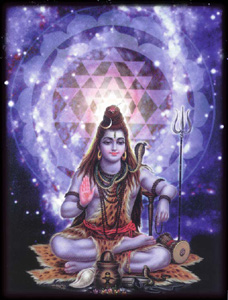 | En el análisis final, Siva es uno de los muchos nombres por los que se conoce el Creador Supremo. Ahora todos los que creen en Dios, sin excepción, están de acuerdo que el universo existe porque un Creador quiso a la existencia. Si este universo llegó a existir a través del Big Bang, ya que los científicos creen incluido yo mismo o como se describe en diversas teologías, es un asunto diferente; A pesar de estas diferencias, todos los teístas creen que Dios creó el universo de la que somos parte. La mayoría de las religiones no sólo están de acuerdo acerca de la existencia de un Creador Supremo, sino también declaran que Dios es abstracto, sin forma, eterno, omnipresente, omnipotente y omnisciente. Sin embargo, diferentes religiones deciden llamar a este Dios por diferentes nombres, pero ese detalle no es necesario que nos molestan. Ahora la mente humana, como Krishna declara en el Gita, Es infinitamente capaz; sin embargo, la gente común no experimentan el infinito que representa la Mente. Por lo tanto, para la gente común, el concepto de un Dios abstracto, sin forma e infinito no es fácil de entender. Las diferentes religiones tratan de hacer frente a este problema en otros aspectos propios diferentes, a través de la intermediación de simbolismo conveniente. En este sentido, el hinduismo es tal vez el más liberal, dejando por completo al individuo a adoptar cualquier forma que el individuo quiere, y por lo tanto conceptualizar a Dios con Forma de muchas maneras diferentes. Al mismo tiempo, fomentando al mismo tiempo el culto de Dios con el formulario con el fin de desarrollar amor por Dios, antiguas escrituras indias siempre vistos rituales, etc., como paso previo a la realización final ese individuo no es el cuerpo sino el verdadero Ser o Dios . | |
Una representación de la Shiva cósmico |
En otras palabras, el culto de Dios fue un proceso gradual, que tuvo uno de considerar a Dios como un gran proveedor de algo indescriptible, más allá de los atributos, eterno, y más allá del espacio y el tiempo mismo, y que era el Ser interior.
Como Swami ha señalado, Bhakti se desarrolló por primera vez a través de rituales, ya que ayudan a uno a relacionarse personalmente con Dios. Sin embargo, los rituales son como ayudas de flotación que las personas aprender a nadar primer uso; una vez que sepan nadar, tiran las ayudas. De la misma manera una vez que el espíritu de devoción se ha establecido firmemente en el corazón del devoto, él o ella debe pasar al reino superior de relacionarse directamente con Dios en un corazón para base del corazón.
Comprender el significado de la Forma
Veamos ahora por todo esto con cierto detalle, con referencia específica al Señor Siva y los procedimientos que se están siguiendo en el Ati Rudra Maha Yajña ahora en progreso aquí. Como he mencionado anteriormente, la mente humana atribuye al Dios sin forma una forma específica con el fin de ser capaz de relacionarse fácilmente con el Todopoderoso.
En lo que respecta a Siva, la descripción tradicional, junto con la importancia de los atributos es el siguiente:
| 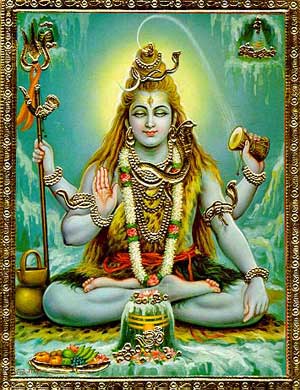 | |
Los 'atributos' del Señor |
- Siva lleva las pieles de tigre, el elefante y el ciervo. El tigre representa el poder que impregna el universo; por lo tanto, la piel de tigre simboliza el dominio sobre toda fuerza. El elefante representa el orgullo y el uso de la piel de elefante, Siva envía el mensaje de que se convierta en uno con Dios, uno debe conquistar primero el orgullo. Del mismo modo el ciervo, lo que hace grandes saltos, representa una mente inconstante; y el uso de la piel de ciervo, el mensaje enviado es que la mente debe ser primero calmó, si uno desea la liberación.
Y así en la lista es interminable. No estoy diciendo que mi descripción es la única manera de entender el simbolismo. El punto es algo diferente. Una vez que se da un formulario a Dios, también se inicia la asignación de atributos. Sin embargo, la asignación de atributos se realiza de una manera tal como para recordar al devoto que Dios está más allá de los atributos asociados con el mundo de los fenómenos.
Volviendo a la forma específica de Siva en el que devotos lo visualizan, es esta forma de Dios único? De ninguna manera - Dios tiene un sinfín de formularios. Luego, en qué forma Él otorga una visión clara para el devoto? La respuesta es que Él se manifiesta en el Formulario devoto anhela, el formulario que otorgaría al devoto la mayor satisfacción. Hablando con humor, Swami dijo una vez que si un búfalo llegara a ser muy devotos, que sea muy probable que pensar en Dios como un Super Buffalo y cuando Dios le otorga una visión que de hecho sería como un Super Buffalo.
 | El famoso novelista indio RK Narayan escribió una historia humorística acerca de los esfuerzos de un tigre para convertirse en espiritual, mediante la búsqueda de la iluminación de un Guru. Un día, el Guru pide al tigre para describir a Dios, y el tigre responde: Dios debe ser un enorme tigre, que abarca la tierra y el cielo, con una cola capaz de rodear el mundo, con las garras que podrían enganchar las nubes, y los dientes que podría moler montañas, y que posee, por supuesto, la fuerza inconmensurable de igualar. Al oír esto, el Gurú se echa a reír y responde: "Usted puede ser toda la razón en el pensamiento de su Dios como un tigre súper. También, puede ser verdad. En el Bhagavad Gita , Dios se revela en una forma aterradora poderosa, que impregna todo el universo en todas sus formas de vida y acción. Recuerde también que Él está dentro de cada uno de nosotros y nos deriva la fuerza de Él ". | |
Sri RK Narayan |
Por lo tanto, llegamos a la conclusión de que mientras que el nombre de Siva y la forma específica atribuida a él son útiles a su manera, que realmente hay que mirar más allá de la forma al aspecto sin forma de Dios. Voy a volver a esa breve. Pero por el momento, ahora me gustaría volver a los rituales.
Cómo rituales Enlazar Devoto Para el Señor
 | Un ritual es básicamente una forma de culto en el que los cantos se acompañan de ciertos procedimientos. Esto se ilustra mejor con la simple adoración de Ganesha que precede a prácticamente todos los rituales aquí. En este hay un pequeño ídolo de Ganesha, y después de los preliminares han terminado, el devoto primero da la bienvenida a Ganesha. ¿Y cómo lo hace? Asentando Ganesha en un tablón y haciendo el gesto de lavar los pies. Este simbolismo tiene un significado específico. En los viejos tiempos, cada vez que un anciano o un invitado respetado llegaron a una casa, lo primero que se hizo fue el anfitrión para asentar el invitado y lavar los pies de los huéspedes. A continuación, Ganesha se da un baño, después de que él se da ropa, seguido por la ofrenda del cordón sagrado, pasta de sándalo, se extiende, etc, etc Hospitalidad completa. Ganesha es adorado con flores a continuación, después de lo cual se le ofrece comida, frutas, etc., rematando todo con Aarathi , como un gesto de reverencia y adoración. En estos días, casi nadie pasa por esta rutina en el espíritu implícito en el procedimiento pero eso no le quita el espíritu. El devoto se relaciona muy intensamente en una base uno a uno con el Señor, así como él sería decir con su Guru , cayendo en una visita. Hay amor y respeto en cada palabra y cada gesto asociado con la bienvenida. Hace algún tiempo, hicimos una característica en H2H en San Tyagaraja, un devoto de toda la vida del Señor Rama. [Haga clic aquí para leer de nuevo]. | |
adorar a Ganesha |
Tyagaraja tenía un conjunto de ídolos que representan Rama, Lakshmana y Sita. Para él, sin embargo, no eran ídolos pero Dios personificado. Tyagaraja relacionado con ellos de una manera muy personal, y cuando, por ejemplo, los ídolos fueron capturados por su hermano en un acto de celos y arrojados al río, Tyagaraja se hizo muy angustiado. Y cuando descubrió los ídolos, por la gracia divina, por supuesto, lo feliz que se hizo y cómo alegremente lo acogió de nuevo en su casa!
Bhakti o el intenso culto del Dios personal, aunque fuera a través de rituales, permite al devoto a tener una relación intensa, personal y mística con Dios y ofrecer amor a Dios con facilidad. Es por ello que en el Gita, Krishna recomienda el culto del Dios personal, es decir, Dios con forma, en comparación con el culto del Dios sin forma.
Me dejó en esta etapa recapitular brevemente lo que he dicho hasta ahora. Empecé con algunos detalles de la contabilidad sobre cuántas veces el Rudram se canta durante la Ati Rudram Maha Yajna . A continuación, hablé de la visualización de Dios en la forma de Siva, con todos los atributos que se le atribuye a él. Esto fue seguido por algunas observaciones sobre cómo el culto de Dios con la forma es muy útil en el camino espiritual, y cómo Krishna mismo recomienda que el culto a la abstracta, Dios sin forma, que puede descarrilar fácilmente a la persona ordinaria. También he descrito, especialmente a través de una breve referencia a la Pujahecho a Ganesha forma rutinaria, la forma ritual de adoración le permite a uno se relacionan de una manera personal a Dios. Esto prepara el escenario para mí hacer ahora algunas observaciones sobre algunos de los procedimientos seguidos en el Ati Rudra Maha Yajna .
Los rituales de la Ati Rudra Maha Yajña
Dejando a un lado los muchos rituales satélite, los tres rituales básicos son: 1) los cantos acompañados por Abhishekam hecho a un lingam, 2) los cantos independientes de la Rudram , y 3) los cantos acompañados de ofrendas al fuego sagrado, es decir, Homam . Permítanme comenzar con la Abhishekam hecho al lingam. Lo que realmente es un lingam? Como Swami ha señalado en muchos de sus discursos Shivaratri, lingam es básicamente una representación de la Creación. Cuando se adora el lingam, uno está simbólicamente gracias a Dios por todas las bondades de creación está llena de, como el aire, el agua, la tierra, etc., el sol que nos da energía, y así sucesivamente. Por ejemplo, uno de los himnos en el el Namakam ocurre, en parte, de esta manera: Postraciones al Señor de todos los cuerpos, el destructor, que protege con su arco de cuerda. Postraciones al cochero, el indestructible, el Señor de los Bosques, postraciones al carmesí, el Señor de los árboles que, existiendo en todo, protege. | 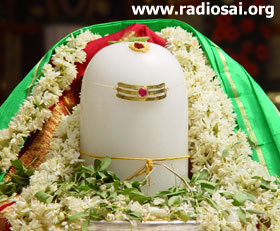 | |
El lingam Adornado por Bhagavan con un rojo 'ojo' |
Claramente, una persona inmersa en el mundo tiene deseos. Swami dice que si usted tiene que pedir, mejor que mendigar de Dios que los humanos. En ese espíritu, algunos de los himnos buscan descaradamente favores como este que cito en parte:
Puedo ser proporcionada comodidades materiales en abundancia en el viaje de mi vida y la capacidad para ponerlos a la mejor utilización.
Aquí es otra muestra:
Puede que se me otorgue los bienes muebles e inmuebles, así como el oro y la plata abundantes.
Pero también hay himnos que buscan un conocimiento más alto, la capacidad de sacrificio, la realización de la finalidad última de la vida y así sucesivamente.
Si tomamos todo esto, vemos una progresión interesante. En primer lugar, el devoto adora al Señor como el Creador Supremo y busca del Señor las bendiciones de la prosperidad material, etc., todos los cuales están relacionados con la Creación. Pero poco a poco enfoque cambia del devoto a cosas más espiritual, es decir, a las cosas que van más allá de la mera materia.
La vida como una peregrinación
Ahora quisiera tratar de poner todo esto en una perspectiva más amplia. Básicamente, uno puede visualizar los rituales como una representación simbólica de la vida como una peregrinación. Inicialmente, no se comprende que Dios es el Morador que reside dentro de nosotros. Gracias a esta ignorancia, uno busca a Dios afuera, en templos hechos por el hombre, en los llamados lugares sagrados, etc. También se intenta cumplir con el deber pero la mente está agitada por las consecuencias del pasado, uno de karma que es. Como resultado, se reza a Dios para la protección, la libertad de los problemas y así sucesivamente. Si esta parte de la vida se maneja adecuadamente, la mente se desarrolla lentamente un poco de madurez y ayuda al individuo a centrarse más en el ejercicio de su Dharma . A medida que el enfoque en Dharmaaumenta, el individuo busca sido unidos a Dios porque que otorga la verdadera paz y la dicha. Y este proceso se ve facilitado por el individuo que busca a Dios dentro en vez de fuera.
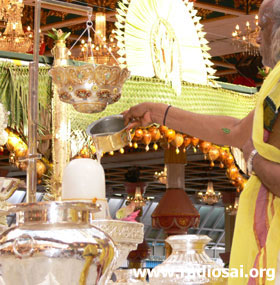 | De paso, tal vez debería mencionar lo siguiente. En estos días cuando uno tiene un baño, uno se da una ducha, al menos en los países avanzados. En la India, en los días pasados, la gente a bañarse en el río o cuando tomaron un baño en casa, ellos verter agua sobre sí mismos utilizando una taza metálica. Y mientras se baña, muchos podrían cantar el Rudram . La idea era que el baño del cuerpo físico, era un símbolo de la realización de Abhishekam al Señor en el interior. Para poner todo de otra manera, el culto simboliza un proceso de tres pasos por así decirlo. En el primer paso, nos encontramos con los de nuestro karma , es decir, las consecuencias de nuestras vidas pasadas, a menudo dolorosa. Que el dolor nos obliga a buscar a Dios y orar a Dios por los favores. A medida que trabajamos a cabo nuestros karmas y adquirir cierto refinamiento espiritual, nos volvemos lentamente centrado en Dharma . Esto nos impulsa hacia adelante en el camino espiritual, que nos ayuda a discriminar lo falso de lo verdadero. En particular, nos movemos progresivamente alejados de objetos materiales y los placeres sensuales a las cosas más eternos y permanentes, es decir, los valores que trascienden la Creación. Eso nos lleva en un hermoso viaje interior que culmina con encontrarse cara a cara con la Conciencia Suprema y finalmente convertirse en uno con ella. | |
Realización Abhishekam al lingam |
Hasta el momento, he hablado sobre el progreso espiritual de un individuo. De hecho, la mayoría de los gurús tienen en el pasado, ha sido principalmente preocupado por ayudar a las personas a pasar de lo finito a lo infinito, de lo transitorio a lo eterno, de la falsedad a la verdad, etc., etc. En este sentido, el viaje espiritual fue esencialmente visto como una caminata solitaria por un individuo. En un cambio radical de este enfoque tradicional, Aurobindo en su lugar difícil de leer Yoga Integral, Aventurado sugerir que la humanidad ha alcanzado una etapa en la que todo un grupo de personas puede y debe evolucionar colectivamente. Aún más interesante es el hecho de que nuestro amado Swami ha estado traduciendo en silencio conceptos teóricos más difusos de Aurobindo en una realidad práctica, con lo que yo llamaría un enfoque verdaderamente revolucionario.
Misión de Sai a elevar a la humanidad
Tomemos, por ejemplo, el Instituto de Swami. En vista de ello, es una Universidad que al igual que sus homólogos en otras partes, ofrece cursos en matemáticas, física, química, etc., además de otros cursos sobre Administración de Empresas, Administración Financiera, Informática y así sucesivamente. Eso es lo que se ve en la superficie; pero mira a continuación y se verá que la Universidad de Bhagavan Baba es un caldero espiritual de una especie única que produce todos los años de una manera coherente y estructurada, cientos y cientos de hombres y mujeres que están listos para servir a la humanidad y elevar en muchos diferentes jóvenes formas.
Mira siguiente a la Organización Seva fundada por Swami. Como dijo una vez Bhagavan, el objetivo básico de la organización es la espiritualidad elevar el individuo involucrado en Seva, pero cuando miles y miles hacen seva desinteresado por todo el mundo durante todo el año, tiene su propio impacto colectivo en elevar un gran número de personas.
Lo mismo puede decirse de los hospitales de Swami. En vista de ello, los hospitales ayudan a los pobres, ofreciéndoles un servicio médico gratuito, incluso a nivel avanzado. Pero mira más profundo y ¿qué encuentras? Estos hospitales proporcionan una maravillosa oportunidad para que muchos médicos y enfermeras que hacen el servicio real. Luego están el gran número de estudiantes de Swami que están sirviendo como oficiales técnicos para un modesto salario, a pesar de que pueden comando de pago mucho más grande fuera, dadas sus habilidades altamente especializadas. Y no olvidemos los muchos otros que están sirviendo en los hospitales en varias capacidades, puramente de forma voluntaria. Por último, están las enormes brigadas Seva Dal que vienen una semana tras otra, de todo el país, para participar en una variedad de servicios de apoyo que van desde el deber de seguridad para el trabajo de lavandería, llevando comida a los pacientes, empujando las sillas de ruedas, En cada una de las instituciones creadas por Swami, grupos de personas que trabajan juntos y coherente para una noble causa común, consiguen colectivamente elevados, es decir espiritualmente. Y la belleza es que las personas que participan reciben levantada sin ser consciente de ello. Aunque a simple vista parece suceder especie de justo; en realidad no, porque Swami está ahí detrás, en silencio orquestar todo. Eso es lo que es único acerca de este avatar; Él ha venido no sólo para dar una mano de ayuda a las personas aquí y allá, pero a grandes sectores de la humanidad. |  | |
Que trabajan como Culto ... Sevadals en el hospital |
En física, tenemos un fenómeno llamado auto-organización en un sistema colectivo, bajo algunas condiciones especiales, presenta unas propiedades extraordinarias. La superconductividad es un ejemplo clásico. Un alambre de plomo puede conducir la electricidad, pero cuando los electrones fluyen en el cable para transportar corriente, que normalmente experimentar resistencia. Si la resistencia es alta, el alambre de hecho se calienta. Pero tomar un alambre de plomo y enfriarlo a una temperatura próxima a cero absoluto; y sabes lo que pasa? Milagrosamente, la resistencia eléctrica desaparece completamente y los electrones puede fluir sin enfrentarse a la menor impedancia. Este es un ejemplo de la auto-organización; cuando las condiciones son adecuadas, todo el sistema se acerca a un estado muy diferente y el comportamiento del sistema cambia dramáticamente.
 | El láser es otro gran ejemplo. Un láser es básicamente un sistema de los átomos de los que emiten luz. Un tubo fluorescente también emite luz; así que lo que es la diferencia entre la luz emitida por el tubo fluorescente y la emitida por un láser? Los átomos en un tubo de descarga emiten luz en todas direcciones y con una gama de frecuencias. Los átomos en un láser se comportan de manera diferente. En primer lugar, la luz emitida sale en una dirección; en segundo lugar el rango de frecuencia es muy estrecha y en tercer lugar, los átomos de todos emiten luz en el paso por así decirlo. Eso es lo que hace que la luz láser muy potente, tan potente que en los casos adecuados incluso puede perforar a través de placas de acero gruesas. También en este caso, una vez que las condiciones son adecuadas, el sistema sólo incendios y comienza la acción láser, como dicen los científicos; esto también es un caso de auto-organización. | |
Luz laser |
Swami nos dice que cuando los individuos en sociedad están en perfecta sintonía con el Dharma , entonces automáticamente que la sociedad se convertiría en autoorganizado y se transforman en Utopía. Esta es la forma en la llamada edad de oro sería la madrugada, cuando la humanidad se convierte en auto-organizada por resonancia de Dharma , y no por medio de la ola de una varita mágica como muchos parecen imaginar.
De paso, debo añadir que desconocemos, Swami nos está empujando hacia adelante con algunos pasos increíbles, pero apenas se dio cuenta. Voy a mencionar sólo dos. No sé cuántos de ustedes nacieron en el momento de la famosa crisis de los misiles en Cuba en los años sesenta, cuando Kennedy fue el presidente de América y Kruschev era el jefe de la antigua Unión Soviética. Recuerdo vívidamente esos días. Hubo un enfrentamiento globo ocular-a-globo ocular entre las dos grandes superpotencias y parecía por unos días de que todo el mundo podría subir en un holocausto nuclear. mensajes que se intercambian duras fueron entre los dos líderes mundiales, y en un momento crucial Kennedy tenía la opción de enviar casi un ultimátum o para enviar un mensaje poco conciliadora que permita a Jruschov a retroceder sin perder la cara.
Los historiadores podrían alabar el enfoque de estadista tomada por Kennedy pero hay que darse cuenta de que en última instancia, nuestras acciones están determinadas por impulsos internos. Si los impulsos son buenos entonces también lo son las acciones resultantes. Narra la historia de Dhruva, Swami dijo una vez que cuando joven Dhruva, a sólo cinco años de edad, estaba en su camino a la selva para hacer tapas , Sage Narada le preguntó al joven muchacho en donde se dirigía. Dhruva respondió que se iba al bosque a hacer tapas . Narada preguntó: "¿Y cómo es exactamente lo que piensa hacer las tapas ?" Dhruva respondió con calma: "El que puso la idea en mi cabeza acerca de ir a la selva sería también me guía de cómo realizar las tapas !" Sí, Dios a menudo funciona de esa manera, sin haciéndose muy evidente. Como Swami declaró una vez: "La coincidencia es un milagro, donde me oculto!" Esto me recuerda a otro gran acontecimiento histórico, el encuentro entre Ronald Reagan y Gorbachov que dio lugar a una distensión notable y llevó a la drástica reducción de los arsenales nucleares en poder de Estados Unidos y Rusia. Posteriormente hubo un cambio dramático en Rusia hasta el punto en que ahora en realidad tantas rusos que vienen a Prashanti Nilayam, algo que simplemente no podríamos haber soñado con, digamos, incluso tan tarde como 1985. | 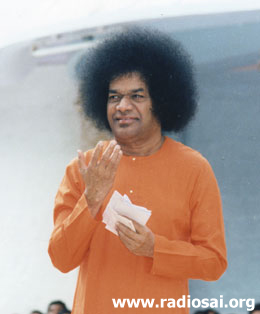 |
Tal vez he estado divagando un poco en esta charla, pero simplemente no podía evitarlo, porque este es un tema de tan vastas proporciones. Para ayudarle, permítanme recapitular brevemente los principales puntos que he hecho hasta ahora.
Me comenzó con algunas observaciones sobre lo que se entiende exactamente por el Ati Rudra Maha Yajnam .
- Entonces dije algo sobre el Señor Shiva, los atributos que se supone que tienen y lo que significan.
- Después de esto pasé a la utilidad de adorar a Dios con la forma.
- Esto me llevó luego a algunos de los detalles de los procedimientos seguidos en la corriente Yajnam .
- a continuación he descrito brevemente cómo, a partir de la adoración ritual del Dios con la forma, se desempeña lentamente a la adoración del Dios sin forma abstracta, que no es más que la conciencia pura.
- También aprovechó la oportunidad para señalar cómo Swami nos está ayudando no sólo a nivel individual a ser mejores espiritualmente sino que de hecho nos levantar juntos al mismo tiempo, por lo que la humanidad en su conjunto podría ver mejores días.
El Yagnam es una llamada para despertar!
Creo que ahora es el momento de terminar. Creo que esta Yajnam es una llamada de atención para todos nosotros para hacer una pausa y reflexionar sobre lo que realmente somos. En resonancia con las vibraciones generadas por los sagrados cantos védicos aquí, tenemos que vemos en un escenario más grande y cósmico y cuál es nuestro verdadero propósito de la existencia como seres humanos. Según yo, el destino humano está determinada por dos factores críticos - de dónde venimos y hacia dónde nos dirigimos. Por lo que la primera se refiere, no hay duda de que los seres humanos han evolucionado a partir de especies inferiores. A su vez, esto significa que, inevitablemente, los seres humanos tendrían huellas, a veces fuertes, de los instintos básicos y tendencias comunes a los animales. Sin embargo, esto no significa que los humanos tienen que ceder a estos instintos y no se levantará a niveles más altos.
La pregunta ahora es a qué nivel se deben subir. Aquí es donde la cuestión del destino final de los humanos entra en acción. Si el individuo cree que él debe deleitarse con los instintos primitivos, pero de una manera sofisticada que la tecnología le permite, entonces él no sería nada más que un animal inteligente o incluso una diablo inteligente, tal vez.
 | Pero es que lo que el nacimiento humano está dotado de? Si creemos que hay un destino superior y más noble que nos llama, entonces hay que buscarla y lograr ese objetivo. Ese objetivo es darse cuenta de nuestra Divinidad latente y ser uno con Dios. El Yajnam que he hablado es un poderoso recordatorio de que la verdad. Mientras que las personas en la India pueden reconocer instintivamente esta verdad gracias a una tradición antigua y rica, no debo dejar de mencionar que los grandes científicos de Occidente también han llegado de forma independiente a la misma conclusión. Einstein, por ejemplo, declaró que él persiguió Ciencia porque le permitió tener, al menos momentáneamente, la experiencia mística del Infinito cósmico. | |
Albert Einstein |
Joven Werner Heisenberg demasiado experimentado este sentimiento de religiosidad cósmica, cuando, a la edad de veintidós o así, descubrió un principio clave de la mecánica cuántica. Como más tarde escribió a su hermana, que se sentía en el momento de su gran descubrimiento, como si estuviera mirando por encima de los hombros de Dios, mientras que el creador escribió la sinfonía de la creación. | 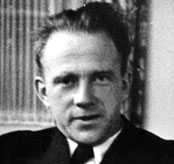 | |
Werner Heisenberg |
 | Erwin Schrodinger, otro de los fundadores de la mecánica cuántica declarado que al final del día, no tenía más remedio que reconocer la profundidad de la declaración védica Aham Brahmasmi - Yo soy Brahman. Por cierto, tanto Heisenberg y Schrodinger ganaron el Premio Nobel. Max Planck, que en un sentido marcó el comienzo de la era de la física cuántica declaró que la conciencia es primaria y que la materia es secundario, siendo una manifestación material de la conciencia. Para el registro, debo mencionar que Planck también era un premio Nobel. | |
Erwin Schrodinger |
Eugene Wigner, otro premio Nobel declaró que la información está completa sólo cuando se ha registrado en la conciencia. Luego está el biólogo de Harvard George Wald, ni que decir tiene otro premio Nobel, quien dijo que a pesar de que un científico que no le gustaba aceptar la idea de la conciencia, que no tenía más remedio que aceptar que la conciencia existido primera y de ella salió toda la Creación, el ser humano, la mejor flor de esta Conciencia Suprema. | 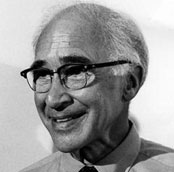 | |
George Wald |
Sí, Siva es la raíz y el apoyo de este universo, y el ritmo de su danza cósmica se refleja en los átomos y en las galaxias del universo. Como físico Fritjof Capra dice,
| 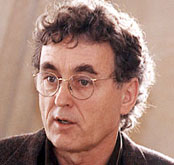 | |
Fritjof Capra |
Capra concluye: "Hace cientos de años, los artistas indios crearon imágenes visuales de Sivas bailando en una hermosa serie de bronces. En nuestro tiempo, los físicos han utilizado la tecnología más avanzada para representar los patrones de que la danza cósmica. La metáfora de la danza cósmica de este modo unifica la mitología antigua, el arte religioso y la física moderna ".
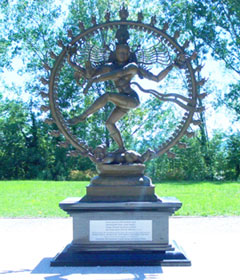 | En la apreciación de los sentimientos de los físicos modernos para la danza de Siva, el Gobierno de la India presentó en junio de 2004 al laboratorio más importantes del mundo en física de partículas, una estatua de dos metro de Nataraja, que representa a Siva dedica a su danza cósmica. Este estatuto se encuentra en las instalaciones del CERN, un laboratorio internacional con sede en Ginebra, donde se han hecho muchos descubrimientos pendientes relacionadas con el microcosmos y su relación con el macrocosmos. Como este gran Yajna en Prashanti serpentea a concluir, devotos, donde quiera que estemos, debe, teniendo la ayuda de los rituales y los cantos, tratar de mirar más allá de modo que nos vemos no en el entorno limitado de la vida cotidiana como el padre , madre, maestro, director general o lo que sea, pero con respecto a dónde venimos y hacia dónde tenemos que ir. Como Swami nos recuerda, a partir de la conciencia todos llegamos y en la conciencia de que debemos finalmente fusionar. Y Siva es una de las representaciones de esa Conciencia Suprema. El culto del lingam, Abhishekams hecho a ella, y las ofrendas al fuego mientras se canta el nombre de Siva tiene toda ayudarnos a centrarnos en nuestro verdadero destino y no el destino falso que el mundo efímero nos tienta con. | |
El baile Nataraja en el CERN, Ginebra |
Espero que usted está de acuerdo con mis conclusiones. Gracias y Jai Sai Ram.
Estimado lector, ¿qué te pareció este suplemento para el tema de portada? Fue informativo y estimulante? Por favor, háganoslo saber en h2h@radiosai.org . Por favor mencione su nombre y país cuando nos escribe. Gracias por tu tiempo.
- El equipo Heart2Heart
The Athi Rudra Maha Yagnam
THE PROFOUND SIGNIFICANCE BEHIND THE POWERFUL SACRIFICE
We reproduce below, the text of a special Musings talk by Prof G. Venkataraman on the subject of Ati Rudra Maha Yajna, broadcast earlier over Radio Sai.
Loving Sai Ram, and greetings from Prashanti Nilayam. The Ati Rudra Maha Yajna is now in full swing here, and it is only appropriate that I devote this special talk to that subject. Before I say anything on the Yajna proper, I must first offer the disclaimer that I am no Vedic scholar. Whatever I say on the technical aspects is based on material I have gathered from various sources, including scholars behind the event here. It is likely that there could be errors due to the incompleteness of my understanding, for which I make my apologies in advance.
The Ati Rudra Maha Yajna is addressed specifically to Lord Siva; as such, my remarks would be structured as follows:
I shall begin by saying something about this particular Yajna, the chanting aspects that is.
- Next, considering that this Yajna is addressed to Lord Siva, I shall say something about Siva, how He is represented, and what that representation means.
- This would then lead me on to some more comments about the chants that characterise this particular Yajna.
- After this, I shall say something about what really lies behind ritualistic worship, etc.
- I shall then wind up with a few general remarks on the broader significance of this Yajna and why it is important.
The Chants of the Rudram
With this preamble, let me get down to business and start with Rudram. The word Rudram usually refers to a special chant, a celebrated one actually, that occurs in the Yajur Veda. The Rudram is heard almost everyday here in Prashanti. I should point out that what is commonly referred to as the Rudram, has two parts; the first of these is called Namakam while the second one is called Chamakam. Most of the hymns of Namakam end with the words namo or namaha. Similarly, the ending of many of the hymns of Chamakam is cha me. The hymns are organised into portions called Anuvakams.
Normally, one chant of the Namakam followed by one chant of the Chamakamconstitutes one Rudram. There is a long-standing traditional belief that chanting the Rudram confers benefits of various kinds. For example, chanting it a few times grants freedom from disease, worldly difficulties, etc. As the number of the repetition increases, one is supposed to get progressively more and more benefits but at some stage, the benefits switch from being worldly to spiritual, the culmination being becoming one with God. In functions like the one going on here, the word Rudram representing the basic unit of chant is defined slightly differently. Glossing slightly over the details, the basic unit consists of the chanting of the Namakam 11 times followed by one chant of the Chamakam. If eleven persons do this simultaneously, we have essentially 11x11 or 121 collective chants, which is called Ekadasa Rudram. |  | |
Mellifluous mantras |
When the basic module is chanted 11x11x11 or 1,331 times, we have a Maha Rudram, and when it is chanted 11x11x11x11 or 14,641 times, we have an Ati Rudram. In the present Yajna, this total score of 14,641 repetitive chants of the Rudram would be achieved by 121 priests doing the chants over 11 days. That roughly is the bookkeeping as far as the chants are concerned. For the record I should mention that this total score of 14,641 could be achieved by one individual, of course, spreading the chant over many, many days; on the other hand, with a large enough team, it could all be done in one day itself. I should also mention that while this is the first time the Ati Rudra Maha Yajna is being performed in Prashanti Nilayam, the Maha Rudram version has been performed once, way back in 1955.
Ritualistic worship does not consist merely of Vedic chants, though chants form the backbone. Often they are accompanied by procedures of various kinds, the most important of which in this case are 1) Abhishekam and 2) offerings made to the sacred fire, or Homam as it is called. In the current Yajna, the Abhishekam would be offered to a special Lingam, everyday. The Yajna also features eleven sacred fires, to which offerings are made, once again to the accompaniment of chants based on the Rudram. Maybe you have not understood all that I have said but let that not bother you. Soon we shall be bringing out a video documentary that would enable you to actually see all that I am now describing with words.
Worshipping The Form of God
Let me now turn to Lord Siva, to whom this Yajna is specifically addressed. Who exactly is this Siva? Folklore is of course full of details about who Siva is, but I would like to view the matter in a slightly larger perspective than usual.
 | In the ultimate analysis, Siva is one of the many names by which the Supreme Creator is known. Now all who believe in God agree without exception that the Universe exists because a Creator willed it into existence. Whether this Universe came into existence via the Big Bang, as scientists including myself believe or as described in various theologies, is a different matter; despite these differences, all theists believe that God created the Universe of which we are a part. Most religions not only agree about the existence of a Supreme Creator but also declare that God is abstract, formless, eternal, omnipresent, omnipotent and omniscient. However, different religions choose to call this God by different names but that detail need not bother us. Now the human Mind, as Krishna declares in the Gita, is infinitely capable; yet, ordinary people do not experience the infinity that the Mind represents. Thus, for ordinary people, the concept of an abstract, formless and infinite God is not easy to grasp. Different religions try to deal with this problem in other own different ways, via the intermediary of convenient symbolism. In this respect, Hinduism is perhaps the most liberal, leaving it entirely to the individual to adopt whatever form the individual wants, and thus conceptualise God with Form in many different ways. At the same time, while encouraging the worship of God with Form in order to develop Love for God, ancient Indian scriptures always viewed rituals etc., as a stepping stone to the ultimate realisation that individual is not the body but the Real Self or God. | |
One depiction of the Cosmic Shiva |
In other words, worship of God was a graded process, which took one from regarding God as a great provider to something indescribable, beyond attributes, eternal, and beyond Space and Time itself, and who was the Self within.
As Swami has pointed out, Bhakti is first developed via rituals because they help one to relate personally to God. However, rituals are like floatation aids that people learning to swim first use; once they know how to swim, they throw away the aids. In the same way once the spirit of devotion is established firmly in the heart of the devotee, he or she should move to the higher realm of relating to God directly on a Heart to Heart basis.
Understanding The Significance of the Form
Let us now look at all this in some detail, with specific reference to Lord Siva and the procedures that are being followed in the Ati Rudra Maha Yajna now in progress here. As I mentioned earlier, the human Mind ascribes to the Formless God a specific Form so as to be able to easily relate to the Almighty.
Where Siva is concerned, the traditional description, together with the significance of the attributes is as follows:
|  | |
The 'Attributes' of the Lord |
- Siva wears the skins of the tiger, the elephant and the deer. The tiger represents power that pervades the universe; thus, the tiger skin symbolises mastery over every force. The elephant represents pride and wearing the elephant skin, Siva sends the message that to become one with God, one must first conquer pride. Similarly the deer, which makes big leaps, represents a fickle Mind; and wearing the deerskin, the message sent is that Mind must first be stilled, if one wants liberation.
And so on the list goes. I am not saying that my description is the only way of understanding the symbolism. The point is somewhat different. Once one gives a Form to God, one also starts assigning attributes. However, the assignment of attributes is done in such a manner as to remind the devotee that God is beyond the attributes associated with the phenomenal world.
Getting back to the specific form of Siva in which devotees visualise Him, is this form of God unique? By no means - God has endless Forms. Then in what Form does He grant a clear vision to the devotee? The answer is that He manifests in the Form the devotee yearns for, the Form that would grant the devotee the highest satisfaction. Speaking humorously, Swami once said that if a buffalo were to become very devout, it would quite likely think of God as a Super Buffalo and when God grants it a Vision it would in fact be as a Super Buffalo.
 | The famous Indian novelist R. K. Narayan wrote a humorous story about the efforts of a tiger to become spiritual, by seeking enlightenment from a Guru. One day, the Guru asks the tiger to describe God, and the tiger replies: God must be an enormous tiger, spanning the earth and sky, with a tail capable of encircling the globe, claws that could hook the clouds, and teeth that could grind mountains, and possessing of course, immeasurable strength to match. Hearing this, the Guru bursts into laughter and replies, "You may be perfectly right in thinking of your God as a super tiger. Also, it may be true. In the Bhagavad Gita, God reveals Himself in a mighty terrifying form, which pervades the whole universe in every form of life and action. Remember also that He is within every one of us and we derive strength from Him." | |
Sri R. K. Narayan |
So we arrive at the conclusion that while the name Siva and the specific form attributed to Him are useful in their own way, we must really look beyond the form to the Formless aspect of God. I shall return to that shortly. But for the moment, I would now like to turn to the rituals.
How Rituals Bind Devotee To The Lord
 | A ritual is basically a form of worship in which chants are accompanied by certain procedures. This is best illustrated by the simple worship of Lord Ganesha that precedes practically every ritual here. In this there is a small idol of Lord Ganesha, and after the preliminaries are over, the devotee first welcomes Ganesha. And how does he do it? By seating Ganesha on a plank and making the gesture of washing the feet. This symbolism has a specific meaning. In the olden days, whenever an elder or a revered guest came to a house, the first thing that the host did was to seat the guest and wash the feet of the guest. Next, Ganesha is given a bath, after that He is given clothes, followed by the offering of the sacred thread, sandalwood paste, etc. etc. Full hospitality is extended. Ganesha is then worshipped with flowers, after which He is offered food, fruits etc., topping it all off with Aarathi, as a gesture of reverence and worship. These days, hardly anyone goes through this routine in the spirit implied in the procedure but that does not take away the spirit. The devotee relates very intensely on a one to one basis with the Lord, even as he would with say his Guru, dropping in for a visit. There is love and respect in every word and every gesture associated with the welcome. Sometime ago, we did a feature in H2H on Saint Tyagaraja, a life-long devotee of Lord Rama. [Click here to read again]. | |
Worshipping Ganesha |
Tyagaraja had a set of idols representing Rama, Lakshmana and Sita. For him, however, they were not idols but God personified. Tyagaraja related to them in an intensely personal way, and when, for example, the idols were seized by his brother in an act of jealousy and thrown into the river, Tyagaraja became extremely distraught. And when he discovered the idols, by Divine Grace of course, how happy he became and how joyously he welcomed the Lord back into his home!
Bhakti or the intense worship of the personal God, even if it were via rituals, enables the devotee to have an intense, personal and mystical relationship with God and offer Love to God easily. That is why in the Gita, Krishna recommends the worship of the personal God, that is, God with Form, as compared to the worship of the Formless God.
Let me at this stage briefly recap what I have said thus far. I started off with some bookkeeping details about how many times the Rudram is chanted during the Ati Rudram Maha Yajna. I then talked about visualising God in the form of Siva, with all the attributes that are ascribed to Him. That was followed by some remarks about how worship of God with Form is very helpful in the spiritual path, and how Krishna Himself recommends it over the worship of the Abstract, Formless God, which can easily derail the ordinary person. I also described, especially via a brief reference to the Puja done to Lord Ganesha routinely, how ritualistic worship enables one to relate in a personal way to God. This sets the stage for me to make now a few remarks about some of the procedures followed in the Ati Rudra Maha Yajna.
The Rituals of the Athi Rudra Maha Yajna
Leaving aside the many satellite rituals, the three basic rituals are 1) chants accompanied by Abhishekam done to a Lingam, 2) the stand-alone chants of the Rudram, and 3) chants accompanied by offerings to the sacred fire, that is, Homam. Let me start with the Abhishekam done to the Lingam. What really is a Lingam? As Swami has pointed out in many of His Sivarathri Discourses, Lingam is basically a representation of Creation. When the Lingam is worshipped, one is symbolically thanking God for all the bounties Creation is filled with, like air, water, land etc., the Sun that gives us energy, and so on. For example, one of the hymns in the Namakam goes in part like this: Prostrations to the Lord of all bodies, the destroyer who protects with His stringed bow. Prostrations to the charioteer, the indestructible one, the Lord of the Forests, Prostrations to the crimson one, the Lord of trees who, existing in all, protects. |  | |
The Lingam Adorned by Bhagavan with a Red 'Eye' |
Clearly, a person immersed in the world has desires. Swami says if you have to beg, better to beg from God than humans. In that spirit, some of the hymns unabashedly seek favours like this one that I quote in part:
May I be provided material comforts in abundance in my life's journey and the capacity to put them to the best use.
Here is another sample:
May I be granted movable and immovable property and plentiful gold and silver.
But there are also hymns that seek higher knowledge, the ability to sacrifice, the realisation of the ultimate purpose of life and so on.
If we take all this together, we see an interesting progression. First, the devotee adores the Lord as the Supreme Creator and seeks from the Lord the blessings of material prosperity etc., all of which are related to Creation. But slowly the devotee's focus shifts to things more spiritual, that is, to things that go beyond the mere material.
Life As A Pilgrimage
Let me now try and put all this in a larger perspective. Basically, one can visualise the rituals as a symbolic representation of life as a pilgrimage. Initially, one does not understand that God is the Indweller who resides within us. Thanks to this ignorance, one seeks God outside, in manmade temples, in so-called holy places, etc. One also tries to do one's duty but the Mind is agitated by the consequences of the past, one's karma that is. As a result, one prays to God for protection, freedom from troubles and so on. If this part of life is handled properly, the Mind slowly develops some maturity and helps the individual to focus more on fulfilling his or her Dharma. As the focus on Dharma increases, the individual seeks to become united with God because that grants true Peace and Bliss. And this process is facilitated by the individual seeking God within rather than outside.
 | In passing, I should perhaps mention the following. These days when one has a bath, one takes a shower, at least in the advanced countries. In India in the olden days, people used to bathe in the river or when they took a bath at home, they would pour water over themselves using a metallic mug. And while bathing, many would chant the Rudram. The idea was that bathing of the physical body, was symbolic of performing Abhishekam to the Lord inside. To put it all differently, worship symbolises a three-step process as it were. In the first step, we come to grips with our karma, that is, the consequences of our past lives, often painful. That pain compels us to seek God and pray to Him for favours. As we work out our karmas and acquire some spiritual refinement, we slowly become focussed on Dharma. This propels us forward on the spiritual path, helping us to discriminate the false from the true. In particular, we progressively move away from material objects and sensual pleasures to things more eternal and permanent, that is, values that transcend Creation. That takes us on a beautiful inward journey that culminates with coming face to face with Supreme Consciousness and finally becoming one with it. | |
Performing Abhishekam to the Lingam |
Thus far, I have talked about the spiritual progress of an individual. Indeed, most Gurus have in the past, been mainly preoccupied with helping individuals to go from the finite to the Infinite, from the transient to the Eternal, from untruth to Truth etc., etc. In this sense, the spiritual journey was essentially seen as a lonely trek by an individual. In a radical departure from this traditional approach, Aurobindo in his rather difficult to read Integral Yoga, ventured to suggest that mankind has reached a stage where a whole body of people could and must collectively evolve. Even more interesting is the fact that our beloved Swami has been quietly translating Aurobindo's rather fuzzy theoretical concepts into practical reality, with what I would call a truly revolutionary approach.
Sai's Mission to Uplift Humanity
Take, for example, Swami's Institute. On the face of it, it is a University that like its counterparts elsewhere, offers courses in mathematics, physics, chemistry, etc., besides other courses on Business Administration, Financial Management, Computer Science and so on. That is what one sees on the surface; but look below and you would find that Bhagavan Baba's University is a spiritual cauldron of a unique kind that produces every year in a coherent and structured manner, hundreds and hundreds of young men and women who are ready to serve humanity and uplift it in many different ways.
Look next at the Seva Organisation founded by Swami. As Bhagavan once remarked, the basic aim of the Organisation is to spirituality elevate the individual engaged in Seva, but when thousands and thousands do selfless seva round the world throughout the year, it has its own collective impact in uplifting a large number of people.
The same is true of Swami's Hospitals. On the face of it, the Hospitals help the poor by offering them free medical service, including at the advanced level. But look deeper and what do you find? These Hospitals provide a wonderful chance to so many doctors and nurses to do real service. Then there are the large number of Swami's students who are serving as Technical Officers for a modest salary, even though they can command much bigger pay outside, given their highly specialised skills. And let us not forget the many others who are serving in the Hospitals in various capacities, purely on a voluntary basis. Finally, there are the huge Seva Dal brigades that come week after week, from all over the country, to engage in a variety of support services that range from security duty to laundry work, carrying food to the patients, pushing wheel chairs, and so on. In every one of the institutions created by Swami, groups of people working coherently together and for a common noble cause, get collectively elevated, spiritually that is. And the beauty is that people involved get uplifted without being conscious of it. Superficially it seems to sort of just happen; not really, because Swami is there behind, silently orchestrating it all. That is what is unique about this Avatar; He has come not merely to give a helping hand to individuals here and there but to large sections of humanity. |  | |
Working as Worship...Sevadals at the hospital |
In physics, we have a phenomenon called self-organisation where a collective system, under some special conditions, exhibits extra-ordinary properties. Superconductivity is a classic example. A wire made of lead can conduct electricity, but when the electrons flow in the wire to carry current, they normally experience resistance. If the resistance is high, the wire in fact gets hot. But take a wire made of lead and cool it to a temperature close to absolute zero; and you know what happens? Miraculously, the electrical resistance vanishes completely and the electrons can flow without facing the slightest impedance. This is an example of self-organisation; when the conditions are right, the entire system goes over to a very different state and the behaviour of the system changes dramatically.
 | The laser is another great example. A laser is basically a system the atoms of which emit light. A fluorescent tube also emits light; so what is the difference between the light emitted by fluorescent tube and that emitted by a laser? The atoms in a discharge tube emit light in all directions and with a range of frequencies. The atoms in a laser behave differently. Firstly, the light emitted comes out in one direction; secondly the frequency range is very narrow and thirdly, the atoms all emit light in step as it were. That is what makes the laser light very powerful, so powerful that in suitable cases it can even drill through thick steel plates. Here too, once the conditions are right, the system just fires and starts lasing, as scientists say; this also is a case of self-organisation. | |
Laser Light |
Swami is telling us that when individuals in Society all are in perfect step with Dharma, then automatically that Society would become self-organised and transform into Utopia. This is how the so-called Golden Age would dawn, when mankind becomes self-organised by resonating to Dharma, and not through the wave of a magic wand as many seem to imagine.
In passing, I might add that unknown to us, Swami is nudging us forward with some incredible but hardly noticed steps. I shall mention just two. I don't know how many of you were born at the time of the famous Cuban missile crisis in the early sixties, when Kennedy was the President of America and Khrushchev was the boss of the erstwhile Soviet Union. I remember those days vividly. There was an eye-ball-to-eye-ball confrontation between the two great super powers and it seemed for a few days that the whole world might go up in a nuclear holocaust. Tough messages were being exchanged between the two world leaders, and at a crucial moment Kennedy had the option to send almost an ultimatum or to send a slightly conciliatory message that would enable Khrushchev to back off without losing face. Kennedy chose the latter option and dramatically the crisis eased off.
Historians might praise the statesman-like approach taken by Kennedy but we must realise that ultimately our actions are determined by inner promptings. If the promptings are good then so are the resulting actions. Narrating the story of Dhruva, Swami once said that when young Dhruva, a mere five-year old, was on his way to the forest to do tapas, Sage Narada asked the young lad where he was headed. Dhruva replied that he was going to the forest to do tapas. Narada then asked, "And how exactly do you plan to do the tapas?" Dhruva calmly replied, "He who put the idea in my head about going to the forest would also guide me how to perform the tapas!" Yes, God often works that way, without making Himself very evident. As Swami once declared, "Coincidence is a miracle where I hide Myself!" This reminds me of another great historical event, the meeting between Ronald Regan and Gorbachev that resulted in a remarkable détente and led to the drastic reduction of the nuclear arsenals held by America and Russia. Subsequently there was a dramatic change in Russia to the point where we now actually have so many Russians coming to Prashanti Nilayam, something we simply could not have dreamt of, say even as late as 1985. |  |
Perhaps I have been rambling somewhat in this talk but I just could not help it because this is a subject of such vast proportions. To help you, let me briefly recap the main points I have made thus far.
I started off with a few remarks about what exactly is meant by the Athi Rudra Maha Yajnam.
- I then said something about Lord Siva, the attributes He is supposed to have and what they mean.
- After this I moved on to the utility of worshipping God with Form.
- This took me then to some of the specifics of the procedures followed in the current Yajnam.
- I then described briefly how, starting with the ritualistic worship of the God with Form, one slowly evolves to the adoration of the Formless Abstract God who is nothing but Pure Consciousness.
- I also took the opportunity to point out how Swami is helping us not only at the individual level to become better spiritually but is in fact lifting us all together at the same time, so that humanity as whole would see better days.
The Yagnam is a Call to Wake Up!
I guess it is now time to wind up. I believe that this Yajnam is a wakeup call for all of us to pause and reflect on who we really are. Resonating with the sacred vibrations generated by the Vedic chants here, we must see ourselves in a larger and Cosmic setting and what our real purpose of existence as humans is. According to me, human destiny is determined by two critical factors – where we came from and where we are headed. As far as the first is concerned, there is no question that humans have evolved from lower species. In turn, this means that inevitably humans would have traces, sometimes strong, of the basic instincts and tendencies common to animals. However, this does not mean humans have to yield to these instincts and not rise to higher levels.
The question now is to what level they must rise. This is where the question of the final destiny of humans comes in. If the individual believes that he must revel in the primitive instincts but in a sophisticated way that technology enables him to, then he would be nothing more than a clever animal or even a clever devil perhaps.
 | But is that what human birth is gifted for? If we believe that there is a higher and nobler destiny that beckons us, then we must seek it and reach that goal. That goal is to realise our latent Divinity and become one with God. The Yajnam that I have talked about is a powerful reminder of that truth. While people in India can instinctively recognise this truth thanks to an ancient and rich tradition, I must not omit to mention that great scientists in the West have also independently come to the same conclusion. Einstein, for example, declared that he pursued Science because it enabled him to have, at least fleetingly, the mystical experience of Cosmic Infinity. | |
Albert Einstein |
Young Werner Heisenberg too experienced this Cosmic feeling of religiosity when, at the age of twenty two or so, he discovered a key principle of quantum mechanics. As he later wrote to his sister, he felt at the moment of his great discovery as if he was looking over the shoulders of God while the Creator wrote the symphony of Creation. |  | |
Werner Heisenberg |
 | Erwin Schrodinger, another of the founders of quantum mechanics declared that at the end of the day, he had no choice but to recognise the profundity of the Vedic declaration Aham Brahmasmi – I am Brahman. By the way, both Heisenberg and Schrodinger won the Nobel Prize. Max Planck who in a sense ushered in the era of quantum physics declared that Consciousness is primary and that matter is secondary, being a material manifestation of Consciousness. For the record, I must mention that Planck too was a Nobelist. | |
Erwin Schrodinger |
Eugene Wigner, another Nobel Prize winner declared that information is complete only when it is registered in Consciousness. Then there is the Harvard biologist George Wald, needless to say another Nobelist, who said that though as a scientist he did not like accepting the idea of Consciousness, he had no choice but to accept that Consciousness existed first and from it came all Creation, the human being the finest flower of this Supreme Consciousness. |  | |
George Wald |
Yes, Siva is the root and support of this universe, and the rhythm of His Cosmic dance is reflected in the atoms and in the galaxies of the universe. As physicist Fritjof Capra says,
|  | |
Fritjof Capra |
Capra concludes, "Hundreds of years ago, Indian artists created visual images of dancing Sivas in a beautiful series of bronzes. In our time, physicists have used the most advanced technology to portray the patterns of that cosmic dance. The metaphor of the cosmic dance thus unifies ancient mythology, religious art and modern physics."
 | In appreciation of the feelings of modern physicists for Siva's dance, the Government of India presented in June 2004 to the world's leading laboratory in particle physics, a two metre tall statue of Nataraja, representing Siva engaged in His Cosmic Dance. This statute stands in the premises of CERN, an international laboratory located in Geneva, where many outstanding discoveries relating to the microcosm and its relationship to the macrocosm have been made. As this great Yajna in Prashanti winds its way to conclusion, we devotees, wherever we are, must, taking help from the rituals and the chants, try to look far beyond so that we see ourselves not in the limited setting of daily life as father, mother, teacher, CEO or whatever, but with respect to where we came from and where we ought to go. As Swami reminds us, from Consciousness we all came and in Consciousness we must finally merge. And Siva is one of the representations of that Supreme Consciousness. The worship of the Lingam, Abhishekams done to it, and the offerings made to the fire while chanting the name of Siva must all help us to focus on our true destiny and not the false destiny that the ephemeral world tempts us with. | |
The Dancing Nataraja at CERN,Geneva |
I hope you agree with my conclusions. Thank you and Jai Sai Ram.
Dear Reader, how did you like this supplement to the cover story? Was it informative and inspiring? Please let us know at h2h@radiosai.org. Please mention your name and country when you write to us. Thank you for your time.
– Heart2Heart team














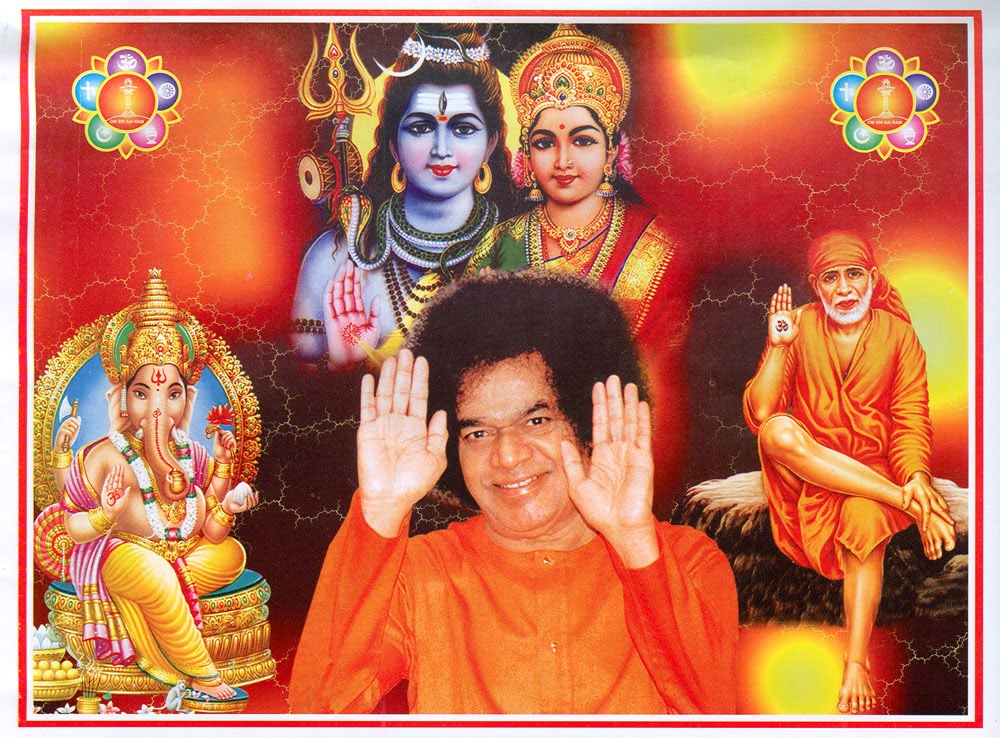







No hay comentarios :
Publicar un comentario